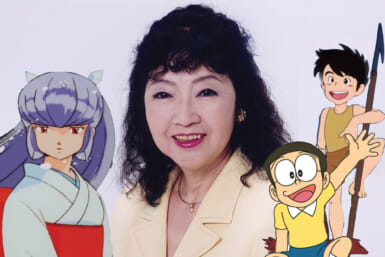by Elyse M. Rogers
CURING COLOR BLINDNESS
Recently, at the invitation of Dr. Taketoshi Yamada, I went to visit the Mejiro Medical Clinic where they have a treatment for color blindness. The clinic has expanded a lot since my last visit, and two new clinics have been added in Osaka and in Fukuoka, Kyushu.
Taketoshi Yamada’s idea of a colorblindness cure is a unique concept. According to Western medical thinking, colorblindness is not treatable or curable, so foreigners have wondered if this purported “cure” really docs work. As I explained to the Yamada family (four family members arc involved in the business), we gaijin are a skeptical bunch. So, they dutifully toured me around the clinic, answered my questions and gave me lots of “satisfied customer” literature to pass on to you.
COLORBLINDNESS
Before we get into the Yamada’s treatment for colorblindness, let’s review a bit about the condition itself.
Those who are colorblind are unable to distinguish between certain colors. It’s a genetic condition and works like this: the male has only one gene of color sense while the female has two. The mother gives her son the color gene, while both father and mother give one to the daughter. If the son receives a normal color gene from his mother he has normal color perception; if he receives a colorblind gene he is colorblind.
The daughter, however, since she receives two genes, has an extra possibility. If both color genes she receives are normal, she will have normal color perception; even if she receives only one normal color gene she will still have normal color perception. Only if both her genes arc colorblind ones will she be afflicted—a rare situation, and why we think of colorblindness as mainly a male trait. Still, if the woman has one abnormal or colorblind gene she is considered a carrier since she can pass on the defective gene to her son. Whew! Got all that?
It’s an interesting cross-cultural point that while colorblindness may be simply an inconvenient or unhappy affliction for foreigners, in Japan (and some other parts of Asia) it can have serious consequences. Color tests are used frequently during childhood in Japan, and those with a diagnosis of “colorblindness” may have difficulty being accepted into some schools, universities and even major companies.
In addition, since the trait is passed genetically, mothers of colorblind children are often made to feel guilty or arc not considered to be suitable marriage partners. So, most people in Japan have a real incentive to avoid the colorblind-label, or to find some way to shed it if they do get it.
THE MEJIRO CLINIC (WADO DOCTORS GROUP) SYSTEM
The Yamadas’ method of treatment for dychromatopsia (the medical term for colorblindness) is a complicated one called the JPJC System. The initials, at least, are easy to understand—they refer to Just Point, Just Channel.
The “points” and “channels” are based on the electromagnetic nature of the human body and its array of ions and enzymes which can be influenced electronically. This is similar to the Meridian Theory of Oriental Medicine as we know from shiatsu and acupunture.
Although the application of medical electronics to treatment is still very new in Western medicine, its use for diagnosis has been popular for many years. The electrocardiogram, for diagnosing irregularities of heart action, is one example. Today there is growing interest in the area of electronic medicine since the body is truly a very impressive electromagnetic field. When we consider that there are approximately 60 trillion cells that each have a structure similar to a magnet, you can sec the magnitude (sorry, couldn’t resist) of the possibilities.
But let’s get back to the theory behind the JPJC treatment which assumes that when there is a lesion, abnormality or simply a malfunction somewhere in the body, there will be a place on the skin that will easily accept the electricity. These critical points are similar to tsubo, the effective spot for applying acupuncture needles. A tsubo is a tiny spot, about 0.25 mm in diameter and can be measured only with special, sensitive instruments.
According to the JPJC theory, if this exact point (the Just Point) is stimulated electronically, the corresponding abnormality or malfunction in the human body will be corrected.
When two or more proper combination of Just Points arc defined, this stimulation flows through a Just Channel and a patient’s color sense improves.
THE TREATMENT
You might expect the Yamadas’ Mejiro Clinic to look like some space-age electronic control room, humming with huge machines constantly blinking and whirring. But such is not the case. The computer terminals are housed in a separate room, out of sight of patients. The main clinic room is a large one with separate booths to serve individual patients. These booths are airy and open, sort of like side-by-side library carrels.
After color testing, an individual program is designed by the attending doctor and the patient is instructed in the program. The patient actually treats himself after that, and writes up his own chart. After each treatment, the patient is retested on the Ishihara charts, and his progress is noted.
At the start of treatment, tiny applicators (electrodes) are attached to each car, and short bursts of mild electronic stimulation (about 59 milliamperes) are applied to the patient. The dosage and duration of stimulation is controlled by computer. The patient finds his own “Just Points” which he learns are those points where the brightest “flash” is perceived.
HISTORY BEHIND THE JPJC TREATMENT
You may be wondering how the treatment came about. Actually, it’s a fascinating story, mostly about one man— Taketoshi Yamada.
In 1975 at age 47, Taketoshi Yamada was a dynamic and successful businessman. Educated as a veterinarian he h become a world traveler, gave advice to governments, listed international leaders among his friends and spoke at many international universities. Anyone who’d seen him then would have thought “This guy’s got it made.”
But tragedy struck in the form of an incurable disease called Behcet’s Syndrome, a multisystem inflammatory disorder that tends to affect the blood vessels and the nervous system. After visiting physicians all over the world looking for some answer to his physical degeneration. Dr. Yamada returned to Japan where he met and married his wife, Noriko Yamada who is a medical doctor; she was the first one to correctly diagnose him as having Behcet’s Syndrome.
Taketoshi Yamada and his wife spent hours trying to find a way to cure him, and finally organized a group of experts for that purpose. Today, that group is known as the Wado Doctors Group (Taketoshi Yamada is chairman), and has representatives from seven fields of science: basic medicine, clinical medicine, psychosomatic medicine. Oriental medicine, biochemistry, medical electronics and human engineering.
Since blindness is often unhappy result of the syndrome, the group researched eye problems. It was during this extensive research that the group tangentially stumbled onto the problem of colorblindness and then later worked on developing a cure.
You might be interested to know that Dr. Taketoshi Yamada is now a genki, energetic and hard-working man of 59 who runs circles around many of his staff and friends.
DOES THE TREATMENT REALLY CURE COLORBLINDNESS?
The Yamadas are passionate about the fact that their treatment safely cures colorblindness, but they do not have the usual “scientifically controlled studies” to back up that belief. I’m told that one Japanese expert, however, has stepped forward and verified the efficacy of the treatment. He is Professor Seki at Tokyo Medical School who is a specialist in dychromalopsia.
When asked why Dr. Yamada has not followed the traditional “medical journal publication” route to validate the effectiveness of the JPJC treatment program, his wife — the clinic-director — told me, “We feel our 70,000 cured patients are the best kind of medical proof.” And those patients are enthusiastic and vocal, let me tell you. Thousands of patients have written in to say that the cure worked and “was like a miracle.” And many, many of them have told their friends about the treatment ; for years, “word of mouth” was the only clinic advertising.
So, since the treatment is not harmful and appears to have helped a host of folks, if you are colorblind and don’t want to be, you might want to try this unorthodox, but seemingly effective, treatment.
CLINIC FEES AND LOCATION
To take the Yamadas’ treatment you have to have poor color perception, a willing heart and a bit of okane. And not surprisingly, the treatment is not covered by Japanese health insurance kenko hoken. (Nor are acupuncture and shiatsu.)
• Regular Treatment Program — Usually it takes 40-50 treatments of 30 minutes each to complete the prescribed program. Treatments can be daily, weekly or whenever convenient for the patient. The fee includes all treatment and aftercare but must be paid in advance: adults, ¥140,000; students (over 14 years of age), ¥120,000; children (under 14), ¥100,000.
• Special Treatment Program Taketoshi Yamada has developed a new “Sixty Member System” that he says works more efficiently and is more comfortable than the regular program. Since it’s much more expensive, only those who have more money than time will probably be interested. The all-inclusive fee for the new, faster program—¥600,000.
All visits are by appointment, but an appointment can usually be made as late as an hour or so before. Also, you won’t believe these clinic hours. TheYamadas proudly told me, “We’re open 365 days a year!” Monday through Saturday, 10 a.m.-7 p.m., Sundays and holidays, 10 a.m.-3 p.m.
There are three Yamada clinics, but for non-Japanese speakers, the one in Mejiro is best since young Dr. Yamada and Ms. Hisano speak English. If you’re interested in other clinic locations, call the Mejiro Clinic for information.
MEJIRO MEDICAL CLINIC. Just to the left as you exit from Mejiro Station (Yamanote Line), and on the third floor above McDonalds. 3-4-14 Mejiro, Toshima-ku, Tokyo 171. Phone 953-2101.








